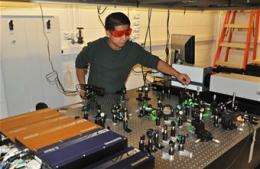Research in microscale heat transfer promises to benefit military systems

(PhysOrg.com) -- A two-year-old Air Force Office of Scientific Research Multidisciplinary University Research Initiative effort involving the University of Michigan, Stanford University, Brown University, and the University of California at Santa Cruz is making great strides in achieving a fundamental understanding of heat transfer at interfaces.
"We aim to accomplish this by applying state-of-the-art techniques from several disciplines to arrive at a set of design rules for engineering interfaces with desired thermal properties," said Dr. Kevin Pipe, a professor of Mechanical Engineering at the University of Michigan who is leading the project.
Heat transfer is important to the performance, power requirements, and reliability of many military and commercial systems including thermoelectric refrigerators, waste heat recovery systems, heat sinks, power electronics, thermal barrier coatings, and thermal interface materials.
"Recent advances in nanoscience have enabled the precise control of interface physical and chemical structure, but the fundamental physics that link this nanoscale structure with thermal transport is not yet well developed, inhibiting the engineering of interfaces with radically enhanced thermal properties," said Pipe.
Interfaces can decrease a composite material's thermal conductivity by scattering the acoustic waves that are the primary carriers of heat in solids.
"This scattering process gives each interface a thermal resistance," said Pipe.
The researchers have made a number of achievements during the first two years of their research effort, including the development of a high-speed thermal imaging system and a technique to measure the propagation of phonons, the elementary packets of vibrational energy that carry heat, with high signal-to-noise ratio. Using ultrafast laser systems that emit laser pulses less than 50 femtoseconds in duration, Pipe's team creates high-frequency acoustic waves at the surface of a material and in a process similar to medical ultrasound imaging measures how these waves scatter off of buried interface structures.
"In one of our measurements," said Pipe, "we use picosecond x-ray pulses to look directly at atomic motion near an interface as heat flows across it."
By applying precise nanofabrication techniques to create interfaces with known atomic structure, the researchers are able to link measured heat transfer properties with the predictions of atomistic simulations to yield further understanding of the fundamental processes involved.
"By advancing the state-of-the-art in these techniques, we aim to fully characterize an interface and achieve a complete understanding of what controls the flow of heat across it," said Pipe.
"The Michigan MURI led by Professor Kevin Pipe is making extraordinary breakthroughs to understand nano-scale thermal transport by precisely tailoring interfaces using advanced processing techniques and innovative experimental laser based methods to delineate phonon modes participating in the heat transport," said Dr. Kumar V. Jata, Thermal Sciences, AFOSR, Arlington, Va. and Materials Science, Asian Office of Aerospace Research and Development, Tokyo, Japan. "In the past we never paid attention to the interfaces and considered them as either perfect or imperfect, one or the other."
Provided by Air Force Office of Scientific Research

















